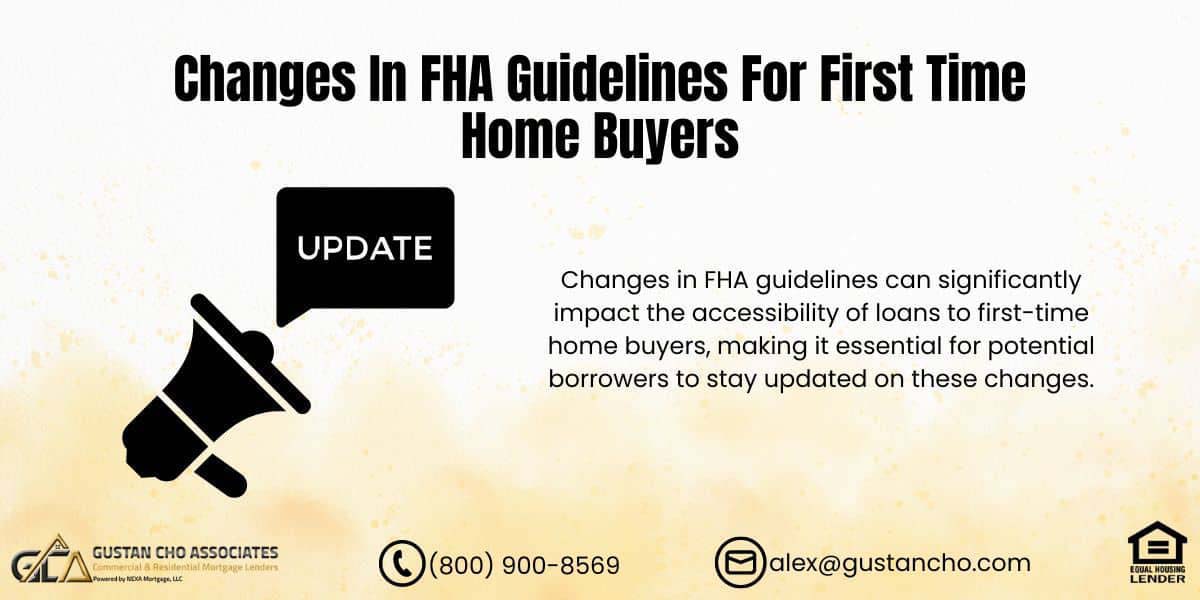This article discusses the changes in FHA guidelines that are particularly relevant to first-time home buyers. The Federal Housing Administration (FHA), which operates under the oversight of the United States Department of Housing and Urban Development (HUD), sets the guidelines for FHA mortgage lending.
The FHA itself does not serve as a lender but instead insures loans provided by FHA-approved private lenders, like banks and mortgage companies. This insurance helps protect lenders if a borrower defaults on their FHA loan, but only if the loans comply with FHA’s established lending guidelines.
Changes in FHA guidelines can significantly impact the accessibility of loans to first-time home buyers, making it essential for potential borrowers to stay updated on these changes.
What are the FHA Changes for 2024?
The FHA changes for 2024 focus on several key areas to make housing more accessible and to adapt to the rising home prices. Here are the main updates:
- Loan Limits: The FHA has increased the loan limits for 2024. The new ceiling for single-unit properties in high-cost areas is $1,149,825, while the floor in low-cost areas is $498,257. This adjustment is to accommodate the increase in home prices across the country.
- Mortgage Insurance Premiums (MIP): The annual MIP rate has been reduced to 0.55% of the loan amount, which aims to make FHA loans more affordable. The duration of the MIP payment varies based on the down payment; it can be for the life of the loan or limited to 11 years if the down payment is 10% or more.
- Streamlined Processes and Enhanced Eligibility: The FHA is introducing a streamlined condo approval process to simplify and speed up the approval process for condominium projects. They have also adjusted eligibility criteria to expand access to FHA loans for a broader range of borrowers.
- Technology Integration: The FHA is integrating more technology to improve the efficiency of its operations, which should make the loan application and management process faster and more user-friendly.
These changes are part of the FHA’s ongoing efforts to provide more flexible and accessible home financing options.
Changes In FHA Guidelines On Student Loans
One significant update in the 2024 Changes In FHA Guidelines pertains to how student loans are handled. Previously, under the old HUD Guidelines, if a student loan was deferred for at least one year, its payment could be omitted from the debt-to-income (DTI) ratio calculations. However, this is now the case with the recent Changes In FHA Guidelines. Now, mortgage underwriters must include the monthly payments of deferred student loans when calculating a borrower’s DTI ratio.
Additionally, the new guidelines stipulate that underwriters must use 1.0% of the total outstanding student loan balance as a hypothetical monthly debt payment in their DTI calculations. This change ensures a more thorough assessment of borrowers’ ability to afford their mortgage alongside their existing student loan obligations.
Ready to Buy Your First Home? Let Us Help You Make the Process Easy and Stress-Free!
Contact us today to get pre-approved and start your home-buying journey with confidence.
Tricks In Lowering Student Loan Payments
Under the recent Changes In FHA Guidelines, individuals carrying substantial student loan debt can reduce their monthly payments by taking specific steps. Borrowers should contact their student loan providers and request a calculation of a hypothetical monthly payment that is fully amortized over an extended period, typically up to 25 years.
This recalculated payment amount, often significantly lower—potentially around 0.50% of the total outstanding loan balance compared to the standard 1.0%—can be used in the debt-to-income ratio calculations required for mortgage approval. Importantly, borrowers must ensure these agreements are documented in writing to be valid for FHA loan consideration.
Using Income-Based Repayment On Conventional Loans
Conventional loans offer the possibility of reconfiguring student loans into an income-based repayment plan, which can significantly lower monthly payments. However, this flexibility is not available with FHA loans:
Under conventional loan standards supported by Fannie Mae and/or Freddie Mac, borrowers can opt for income-based repayment schemes, including those that reduce payments to zero. To be recognized, such arrangements must be reported to all three major credit bureaus.
In cases where these payments aren’t reported, loan officers can perform a credit supplement or a rapid rescore to update credit files. This process ensures that the borrower’s credit information accurately reflects all current obligations.
These differences are part of the ongoing changes in FHA guidelines, highlighting the distinctions between FHA loans and conventional mortgage options.
What is the Maximum DTI for a FHA Loan?
For FHA loans in 2024, the preferred maximum debt-to-income (DTI) ratio is typically 43%. However, exceptions can be made to accommodate higher ratios if compensating factors strengthen the borrower’s financial profile. The flexibility of FHA financing enables more people to qualify for it, even if they have more debt than their income.
Changes In FHA Guidelines For Installment Debts Less Than 10 Months
Previously, under HUD’s mortgage lending guidelines, installment debts with less than 10 months remaining could be omitted from borrowers’ debt-to-income (DTI) ratio calculations.
However, following the changes in FHA guidelines, this exclusion now only applies if these payments are less than or equal to 5% of the borrower’s gross monthly income. Additionally, borrowers are not permitted to pay these debts merely to meet this criterion. This adjustment in the FHA guidelines ensures a more accurate representation of a borrower’s ongoing financial obligations.
Changes In FHA Guidelines With FHA Streamline Refinance
Under the previous FHA Streamline Refinance guidelines, borrowers were required to achieve a tangible financial benefit, specifically a minimum savings of 5% on the combined principal, interest, and mortgage insurance costs.
For instance, if a borrower’s monthly payment for principal and interest totaled $900 and the FHA insurance payment was $150, their overall housing cost amounted to $1,050 per month. To qualify for an FHA Streamline Refinance under these terms, they needed to reduce their monthly payment by at least $52.50, representing 5% of their total housing payment.
This $52.50 monthly savings was the minimum threshold necessary for borrowers to qualify for the refinancing benefits offered under the FHA Streamline Refinance program. This requirement ensured that the refinancing provided a significant financial benefit to the homeowner.
FHA Streamline Refinance Mortgage Guidelines
Under the revised FHA guidelines for Streamline Refinance loans, borrowers must achieve a combined reduction of at least 0.50% from their current interest rate and FHA mortgage insurance premium to qualify for refinancing.
For instance, if a borrower currently has an interest rate of 4.5% combined with a mortgage insurance premium of 1.35%, this totals 5.85%. To qualify under the new guidelines, the sum of the new interest rate and mortgage insurance premium must be at least 0.50% lower, such as a new rate of 4.0% and a premium of 0.85%, totaling 4.85%. The resulting savings from this adjustment would be 1.0%, calculated by subtracting the new total of 4.85% from the original 5.85%.
This change ensures that borrowers benefit financially from the refinancing by lowering their total mortgage costs, encouraging refinancing when it results in genuine savings. This adjustment aligns with the FHA’s goal to help borrowers reduce their financial burden under the updated FHA guidelines.
What is the Upfront MIP for FHA Loans in 2024?
For FHA loans in 2024, the upfront Mortgage Insurance Premium (MIP) is typically 1.75% of the loan amount. Borrowers can pay this fee at closing and spread it out over time by including it in their regular mortgage payments. Remember that all FHA loans require this upfront MIP, regardless of the borrower’s credit score or down payment size.
Changes In FHA Guidelines With Regards To Multiple FHA Loans
Under the previous FHA Guidelines, homebuyers were eligible for a second FHA Loan if they were relocating for work and the new home was closer to their new job location.
However, according to the recent Changes in FHA Guidelines regarding multiple FHA Loans, a homebuyer must demonstrate that the new home is 100 miles away from their current residence to qualify for a second FHA Loan due to job relocation. This adjustment ensures that the new guidelines more accurately reflect significant employment-related moves.
Buying Your First Home? Let Us Help You Unlock the Best Financing Options!
Contact us today to get pre-approved and make your dream of homeownership a reality.
FHA Guidelines With Regards To Non-Taxable Income
Under the changes in FHA guidelines for 2024, the “grossing up” non-taxable income method, such as social security, has been updated. When calculating a borrower’s income, FHA now allows non-taxable income to be increased by using the greater 15% or the borrower’s actual tax rate shown on the most recent tax returns. If a borrower has not filed tax returns, the allowable gross-up rate is 15%. These adjustments are intended to reflect the borrower’s usable income more accurately for loan qualification purposes under the new FHA guidelines.
HUD Guidelines On Manual Underwriting
The previous FHA mortgage lending guidelines allowed manual underwriting decisions regarding credit history based largely on the underwriter’s discretion. However, changes in FHA guidelines have established more structured requirements for manual underwriting:
Review of Payment History
Under the new FHA guidelines, underwriters must meticulously assess the borrower’s payment history. They must verify that all mortgage and installment debt payments have been consistently made on time over the past 12 months.
Late Payment Restrictions
The new rules stipulate that borrowers cannot have more than two instances of 30-day late payments on their mortgage or installment debts within the last 24 months.
Credit Account Considerations
An FHA loan under manual underwriting can be approved if the borrower maintains an acceptable payment history and does not have significant derogatory credit issues on revolving accounts in the previous year. Specifically, a major negative mark is defined as any revolving credit account that is 90 days or more past due or has three or more instances of being 60 days late following the due date.
Explanation Requirement
Borrowers must also provide a comprehensive letter of explanation for any outstanding collection accounts, late payments, and other negative credit entries like judgments, tax liens, and charge-offs, if applicable.
These changes in FHA guidelines aim to ensure that borrowers with a solid recent credit history, despite past credit issues, are considered more fairly for mortgage lending decisions.
FHA Guidelines Excluding Business Debt
Under the previous FHA mortgage lending guidelines, business-related debts like car payments could be omitted from the borrower’s debt-to-income (DTI) ratio calculations, provided the car was registered in the borrower’s name. Still, the payments were made from a business account. This exemption required evidence, such as twelve months of canceled checks, demonstrating that the payments were made from the business account.
This treatment has been revised with the recent Changes in FHA Guidelines. All business debts must be factored into the borrower’s DTI calculations. The only exception to this rule is if the borrower can prove that the business is responsible for the debt.
Acceptable proof shows that the debt payments are regularly recorded in the business’s cash flow statements and reflected on business tax returns. This ensures that the financial responsibility lies with the business, not the individual, which is crucial for the accuracy of the DTI assessment.
If you have any questions on the changes on FHA guidelines or you need to qualify for loans with a lender with no overlays, please contact us at 800-900-8569. Text us for a faster response. Or email us at alex@gustancho.com. The team at Gustan Cho Associates is available 7 days a week, on evenings, weekends, and holidays.
Frequently Asked Questions (FAQ) About Changes In FHA Guidelines For First Time Home Buyers
- What are the FHA changes for 2024? The FHA has recently introduced several key changes aimed at making housing more accessible and streamlining financing. These changes include higher loan limits, reduced MIP rates, a streamlined condo approval process, and the integration of new technology to speed up the loan application process.
- How have FHA guidelines changed regarding student loans? Student loan treatment has changed significantly. Previously, student loan payments deferred for at least a year were excluded from DTI calculations. All monthly student loan payments are included in DTI calculations, using a hypothetical monthly debt of at least 1.0% of the student loan balance. FHA loans will now more strictly consider student loan payments.
- What is the maximum DTI for a FHA loan in 2024? The maximum preferred debt-to-income (DTI) ratio for an FHA loan in 2024 is 43%. Exceptions may be allowed with compensating factors that enhance a borrower’s financial profile, offering some flexibility.
- What is the upfront MIP for FHA loans in 2024? In 2024, if you are applying for FHA loans, you must pay an upfront Mortgage Insurance Premium (MIP) of 1.75% of the total loan amount. This amount can be included in your mortgage and paid off throughout your loan.
- How have FHA guidelines changed for installment debts of less than 10 months? Under the old policy, installment debts with less than 10 months remaining could be excluded from the debt-to-income (DTI) calculations. However, under the new policy, such debts can only be excluded if their cumulative payment is less than or equal to 5% of the borrower’s gross monthly income. Additionally, it’s important to note that borrowers cannot pay down their debts specifically to meet this criterion.
- What are the new rules for FHA Streamline Refinance? The FHA Streamline Refinance now requires a minimum savings of 0.50% off the current interest rate and mortgage insurance premium for approval. This change aims to ensure that refinancing is financially beneficial for the borrower.
- Can you have multiple FHA loans? Under the new guidelines, a borrower may qualify for a second FHA loan for employment relocation purposes only if the new home is at least 100 miles away from their current primary residence.
- How is non-taxable income treated under the new FHA guidelines? When calculating qualifying income, non-taxable income can now be grossed up using the greater 15% or the borrower’s actual tax rate. If the borrower did not file tax returns, a fixed rate of 15% is used.
This blog about the Changes In FHA Guidelines For First Time Home Buyers was updated on April 26th, 2024.
Ready to Own Your First Home? We Can Help You Every Step of the Way!
Looking to Buy Your First Home? We’re Here to Help You Get Approved and Save!










